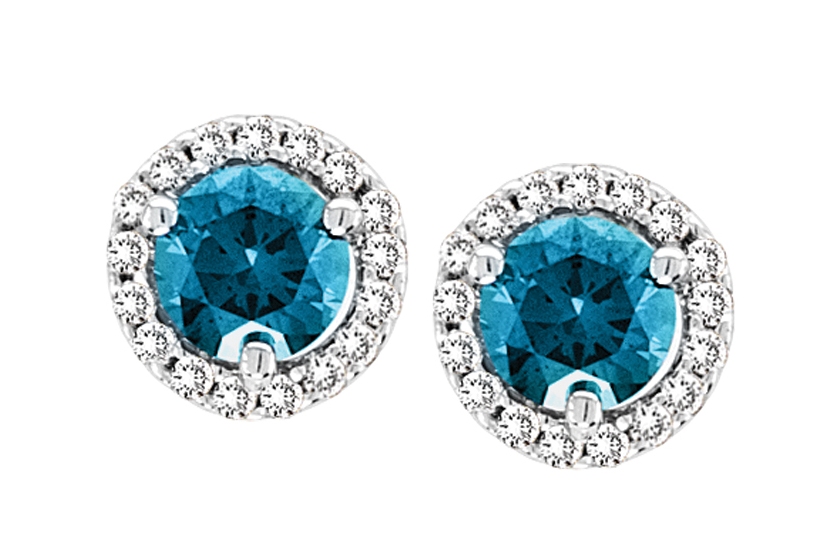Loose diamonds come in a variety of colors. Your jeweler will likely have many of these colored certified loose diamonds on display when you enter their store. Depending on the kind of jewelry you are hoping to design, you will have many choices when it comes to the colored stones you will use to decorate this item. These colored diamonds make perfect accents to some holiday jewelry.  Fancy Colored Blue Diamond Earrings Loose diamonds are formed deep within the earth by Mother Nature herself. These beautiful rocks endure some pretty extreme conditions before being thrust toward the earth's surface via volcanic eruption. It is hard to believe something so gorgeous can be the result of such treacherous conditions. Extreme heat and pressure no living being could ever withstand are to be credited with the formation of these stones. Carbon atoms form very cohesive bonds when exposed to these conditions. Their intricate lattice bonds make them the hardest naturally formed material on the earth. The atoms for a protective layer around them and are called rough loose diamonds. It isn't until a professional diamond cutter gets his or her hands on the rough diamond that the stone becomes cut and polished to sparkle in all of its beauty. Then the diamonds are sold to distributors who will, in turn, sell them to you and me. Now that you know how the loose diamonds are formed in the earth, we will now explore how these stones become colorful. Most people prefer white diamonds. A perfectly white diamond is colorless. Flawless and colorless diamonds are extremely rare and boast an expensive price tag. Most of the white diamonds you see on your friends' jewelry and in the jewelry store has some tint of brown or yellow even if you cannot see it with your own two eyes. Essentially, colored diamonds are flawed diamonds and are not as valuable as their colorless counterparts. However, when it comes to loose diamonds, it all depends on your personal taste. The color of a diamond is determined during the formation process when the diamond is deep under our feet. For example, if the carbon atoms are exposed to boron during the formation process, these loose diamonds will take on a blue tint. Depending on the levels of boron, the diamond will be very blue, barely blue and everything in between. Another example is a black diamond. These diamonds are not typically black the entire way through. The reason they are black is because of the many imperfections within the stone.
Fancy Colored Blue Diamond Earrings Loose diamonds are formed deep within the earth by Mother Nature herself. These beautiful rocks endure some pretty extreme conditions before being thrust toward the earth's surface via volcanic eruption. It is hard to believe something so gorgeous can be the result of such treacherous conditions. Extreme heat and pressure no living being could ever withstand are to be credited with the formation of these stones. Carbon atoms form very cohesive bonds when exposed to these conditions. Their intricate lattice bonds make them the hardest naturally formed material on the earth. The atoms for a protective layer around them and are called rough loose diamonds. It isn't until a professional diamond cutter gets his or her hands on the rough diamond that the stone becomes cut and polished to sparkle in all of its beauty. Then the diamonds are sold to distributors who will, in turn, sell them to you and me. Now that you know how the loose diamonds are formed in the earth, we will now explore how these stones become colorful. Most people prefer white diamonds. A perfectly white diamond is colorless. Flawless and colorless diamonds are extremely rare and boast an expensive price tag. Most of the white diamonds you see on your friends' jewelry and in the jewelry store has some tint of brown or yellow even if you cannot see it with your own two eyes. Essentially, colored diamonds are flawed diamonds and are not as valuable as their colorless counterparts. However, when it comes to loose diamonds, it all depends on your personal taste. The color of a diamond is determined during the formation process when the diamond is deep under our feet. For example, if the carbon atoms are exposed to boron during the formation process, these loose diamonds will take on a blue tint. Depending on the levels of boron, the diamond will be very blue, barely blue and everything in between. Another example is a black diamond. These diamonds are not typically black the entire way through. The reason they are black is because of the many imperfections within the stone.
Find Some Colored Loose Diamonds For Your Holiday Jewelry
By: Amidon Jewelers
